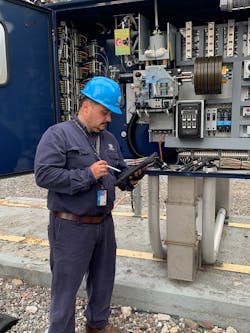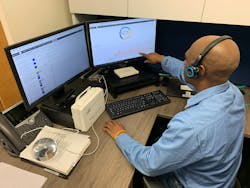User Experience is Critical to Asset Management
Most utilities have a state-of-the-art enterprise asset management system to manage and maintain their equipment. However, collecting and analyzing good data can be challenging and if not done properly, hinder efforts to improve maintenance programs.
To get the most value from their equipment investments, utilities need employees to be fully engaged with their enterprise asset management EAM system. A poor user interface discourages engagement, making it difficult to get good data in and out of software systems. When the user experience is poor, it is challenging to get even those users who are in the system every day to use it effectively, let alone expand the user base to create a more well-informed organization.
Con Edison of New York took a hard look at its data practices and focused on improving processes, data transparency and the tools used to collect, analyze and share data. Now, the utility is getting better results and more productivity.
Obstacles to Good Data
EAM is a group of systems, software and services that enable companies to keep track of operational assets and physical equipment as well as to ensure these assets are used with maximum efficiency. For utilities, this can mean knowing where and how a fleet of trucks is deployed, where field crews spend most of their time, how often tools are serviced and so on. In short, a good EAM system can take in a massive amount of data on a utility’s daily operation and provide managers with useful snapshots of the job being done.
A poor user interface can harm a utility’s performance in each of the three primary EAM categories: operations, maintenance and engineering. The problem is compounded when users struggle to get data into the system and then pull it back out for decision making.
Operations and maintenance personnel interact with the EAM system to identify equipment problems, enter inspection information and document work performed on equipment. Because they are closest to the equipment, they can provide the most valuable information on the effectiveness of a maintenance program. Maintenance personnel also spend most of their time in the field — which is where utilities want them to be — so it is critical to provide a user interface that makes data entry quick and easy.
A poor user interface reduces productivity and data entry tasks cause frustration. This lowers engagement in the process. Following are some common issues symptomatic of a bad user interface:
- Users do not enter information because they are frustrated by the complexity and inefficiency of the EAM system.
- Users enter incorrect information related to the equipment or the work performed.
- Users enter minimal or incomplete information that is of little value for trending or analysis.
Engineering typically enters equipment information and maintenance requirements and extracts information for continuous maintenance improvement. These individuals are further removed from the equipment and must rely on operations and maintenance data to make effective decisions. The user interface to extract the data can be difficult to use, as well. This causes engineers to mistrust and question the system: Is the data bad or do I just not know how to get the right information out? Do I have everything I need to make this decision or are other important data points buried in the software somewhere?
This frustration can lead to making decisions with incomplete information. Even worse, engineers may not use the EAM system and just assume everything is fine. Or, instead of using the system, they may keep asset records outside the system in spreadsheets and data tables. The entire organization suffers because of this lack of engagement in the process.
User Focus
When Con Edison set out to improve its asset management program and better analyze maintenance data, the utility quickly realized the limitations of the available information. The complexity of its EAM system user interface hindered the utility’s ability to collect more complete, higher-quality information, which is important for improving analytics. The utility saw opportunities to enhance work order details on inspections and repairs, the accuracy and consistency of labor hours charged for similar jobs and asset record information. To meet these challenges, Con Edison set out to provide a better user experience for its employees. It sought to increase engagement to get the data needed to improve its asset management program.
Creating a user-friendly system was challenging because of the vast scope of work. Con Edison wanted to improve users’ interaction with the functionality they already had, such as work planning and scheduling, but the utility also wanted to capture all supporting activities outside of the existing EAM system, such as documenting crew availability.
Con Edison decided to proceed in small increments, using an agile approach so it could gauge user feedback on changes introduced. This approach also enabled the utility to improve existing processes, rather than simply replicating inefficient ones in the software. The existing system was not designed to support agile development, so the utility sought a third-party solution to integrate with its EAM system.
Con Edison chose the ENGAGE platform by Endevor LLC. ENGAGE met the utility’s needs in critical ways:
• Information transparency — It is easy to enter and find data in the system, so people are more willing to participate.
• Flexibility — The existing software modules are highly configurable.
• Extensibility — It is easy add new functionality and modules.
• Easy to use — Simple, intelligent screens prompt users for the right information, anticipate their needs based on responses and provide immediate feedback.
These attributes were critical, as Con Edison did not know how the final product would look when it started this project and needed a team of developers to collaborate and provide insight based on industry experience.
Organizational Adoption
The design focus was simple: Give users what they need with the least number of clicks and create an interface so intuitive training is unnecessary. In addition, eliminate duplicate data entries, thereby building productivity improvements into the software. This approach sounds simplistic, but the team applied a lot of effort and all its expertise behind the scenes to reengineer the entire work management process.
The team accomplished this reengineering by asking stakeholders how they worked, who they interacted with and what information they needed to get work done. The team then took this information to decipher requirements vs. preferences and created prototype screen designs users could evaluate. The team gathered and evaluated prototype feedback and modified the product to test user acceptance. Upon successful testing, the team put changes in production and started the cycle over again for the next process improvement.
The rewards for the group’s efforts exceeded expectations. In one year, the productivity of the pilot group improved more than 50%. To put this in context, Con Edison’s project payback period was less than two years for only the pilot group, which represented less than 10% of the user base. In addition to the financial benefits, data quality improved. Engineering could readily access information, and the organization finally was able to measure performance. This enabled continuous improvement.
Achieving organizational adoption of the new system took time. The utility was not just changing software; it was changing its culture. While these changes were taking place, the pilot team continued to strive to find more opportunities and synergies with the platform. As the functionality grew, so did the size of the pilot team, as more subject matter experts wanted to join the process.
Con Edison achieved widespread use and acceptance because of the unprecedented user empowerment. Whereas most EAM systems are implemented from the top down (IT or executive driven), ENGAGE was implemented from the bottom up, focusing on improving the productivity of the people using the software the most. Combined with the quantifiable improvements, the impact this adoption has had on the asset management program’s overall effectiveness is immeasurable.
Better Asset Management
Whether considering the purchase of an EAM system, a third-party solution or an EAM upgrade, make the user interface design an important consideration. Solely identifying requirements without specifying how that functionality should interface with the user and a utility’s business processes is a common mistake.
Con Edison’s investment in people, process and information management has provided a strong foundation for growth and improvement. More operators are using the system today because they do not need training and can get the information out that they need. The combination of a strong culture throughout operations, maintenance and engineering as well as engagement with the processes and data provides true institutional knowledge and continuous improvement. Furthermore, because users can rely on the information they have, the ability to implement more advanced analytics, artificial intelligence and machine reinforcement learning will help Con Edison to achieve an even higher level of automation and efficiency.
Effectively organizing information while providing software users with tools that make it easy to do a job achieves objectives and optimizes asset life-cycle costs. Improving the user interface to simplify entering and accessing information is the first step toward employee engagement on the way to a cycle of continuous program improvement. Better employee engagement results in better asset management as well as a more efficient and successful organization.
Matt Walther is a section manager in the asset management engineering organization at Con Edison in New York. A mechanical engineer with an MBA degree, Walther started his career in construction, operating heavy equipment and managing projects. He has been with Con Edison for more than
25 years, starting as a maintenance supervisor in power generation before moving into asset management with the INPO AP-913 implementation at the Indian Point nuclear plant. After developing the preventive maintenance (PM) basis with the initial rollout of Maximo, Walther moved to substation operations, where he focuses on improving maintenance effectiveness through the implementation of user-friendly work management tools and streamlined processes.
For More Information:
Endevor | www.endevor.com





